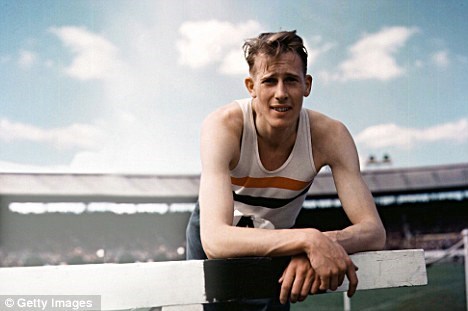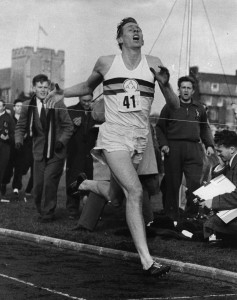 |
| http://impossiblehq.com/impossible-case-study-sir- (Getty Images) |
Roger Bannister was the first person to break the four-minute mile; but how did he do it? Bannister's life started in an ordinary family and wanted to study medicine. He knew that his family wouldn't be able to afford the cost to send him to a university. He later found a talent for running and ended up winning a scholarship to Oxford University in Oxford, England. Roger Bannister was a role model because he was the first person to break the four minute mile, allowed others to do the same, although he did not medal at the Olympics.
Bannister failed to medal at the Olympics but this encouraged him to do something else. Bannister was offered the chance to compete in the Olympics in 1948 but he declined. When he accepted to compete in 1952, he expected himself to win, Britain expected him to win, and everybody thought he would win. A sudden change in schedule disrupted his resting patterns and to his disappointment, he finished in fourth. After the Olympics he decided to prove himself and would amp up his speed training and do what no one else has done at the time, break the four-minute mile.
 |
| Roger Bannister finishing the race. (http://impossiblehq.com/impossible-case-study-sir- (Getty Images)) |
Before Bannister broke the four-minute mile, the previous record for the mile was 4:01. That record stood there for 9 years and didn't move, experts concluded that breaking the four-minute mile was impossible, not hard or dangerous but, physically impossible. They said the only way you could attempt this was when the temperature was perfect, no wind on a dry track, and thousands of people in the crowd. But on May 6th, 1954, it no such day, it was rainy, cold, and the wind was blowing. All that day, Bannister was worried about the weather and whether he should run or not. But he decided to run anyways because he knew he would be beaten if he didn't. Six men entered the race and Bannister took the lead but was overtaken. He started his last lap with a time of 3:07; he had to finish in 53 seconds. He was worried but sped up at the last straight, flew to the lead, and collapsed of exhaustion. The announcement came; "Results of event eight: one mile, First place, R.G. Bannister, in a time which, subject to ratification, is a new track record, British record, European record, common wealth record, and world record- three minutes and." the rest of the sentence was drowned by the crowd. His time was 3:59, he had done it; he had made the impossible, possible.
Bannister opened the door for others to do the same. He proved a lesson we should all know, "once you stop believing something is impossible; it becomes possible". Only 46 days after, the record was broken. Then the record was broken routinely. A few high school runners have run a "sub-four". Although it has been over 60 years, only 1338 people have run a four-minute mile; but there are still people out trying to break the record.
Roger Bannister failed to medal at the Olympics. This failure only made him stronger; he was able to do what no one else did at the time and run a four-minute mile. His accomplishment told others that it was possible. Roger Bannister was a role model because he broke the four-minute mile, proved that others could too, despite not being able to medal at the Olympics. A mile is not a metric unit and is not considered a track event nor is featured in the Olympics.
Page created on 10/5/2015 12:00:00 AM
Last edited 10/5/2015 12:00:00 AM
